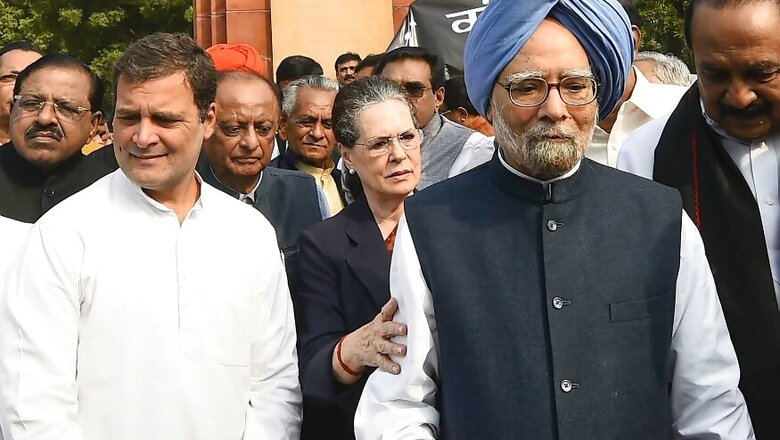
views
The Congress is in the process of reinstalling Rahul Gandhi as the party chief amid a generational rift. Going by this week’s Congress Working Committee (CWC) meeting where the party’s top policy making body spent time in discussing the return of Gandhi instead of the Chinese incursions for which it was called, shows that Gandhis want him to take charge at the earliest, perhaps in view of the health of the party chief Sonia Gandhi. In any case, the party made no secret of the fact that Sonia Gandhi was only an interim president. There was no question of the family allowing any one else to take control. One Rahul loyalist had even suggested that an online convention could be called to declare him the party president again.
As is the Congress practice, the ‘Rahul lao’ chorus was scripted. The person who first raised the issue at the meeting was Rajasthan chief minister Ashok Ghelot, a known Sonia Gandhi loyalist. And soon the chorus picked up.
The spat in the meeting shows the divide in the party is wide open. When RPN Singh suggested that attack on Prime Minister Narendra Modi should be muted, Rahul is reported to have said, “I will continue to raise pressing issues that affect the public at large. I will continue to do what I have been doing. All other issues can be taken up by all of you.” Priyanka Gandhi supported her brother. A similar debate took place on May 25 CWC meeting when Rahul blamed the senior leaders for not supporting him when he took on Modi during the 2019 campaign.
The move to bring back Rahul has resulted in the old guard launching a ‘Rahul Roko’ campaign, creating an unsavory clash between the old guard and the younger leaders in the party. Almost each one of the senior leaders was dreaming of becoming a Manmohan Singh.
The basic question is, why did Rahul resign last August despite the whole party pleading with him not to do so and why is he coming back now? Obviously, he wanted to project himself as a principled and responsible leader. In the scripted drama, the party chose Sonia Gandhi as the interim president indicating that Rahul would come back after a respectable interval. Now that it is almost nearing a year, Rahul’s image-makers want to show that the party is yearning for their young leader to return. In any case, Rahul has been controlling the party from behind albeit without holding office. The old guard feels that this is not the time for him to come back and he should wait till normalcy returns.
Some senior leaders are irked because they are apprehensive of their future if Rahul returns. The power struggle has been going on for long. While there could be no open revolt against Rahul coming back, old guard wants the status quo to continue. They are critical of Rahul’s coterie and feel Rahul has not yet learnt the ropes. They are also critical of Rahul’s strategy of attacking Prime Minister Modi personally, which, in their opinion, would boomerang. Though Sonia has been participating in the meetings with Prime Minister, it is Rahul who has been taking on Modi be it on the Chinese incursions or the government’s handling of the pandemic or the sliding economy.
Rahul had never felt comfortable with the old guard, whom he feels is a stumbling block for his reformist ideas. There is huge pressure on Rahul to effect the generational shift without any more delay. Rahul loyalists argue that the party must have a regular president before Bihar elections later this year.
It is clear that ground has been prepared for the reinstallation of Rahul for some time. Sonia constituted a core committee under the chairmanship of former Prime Minister Manmohan Singh a few weeks ago, which was packed with Rahul loyalists, including KC Venugopal, Randeep Singh Surjewala, Chakravarty and a few others. Manmohan Singh, P Chidambaram and Jairam Ramesh represent the old guard. The exclusions were as significant, as some senior leaders like Ahmed Patel, AK Antony, Anand Sharma and Ghulam Navbi Azad have been left out.
There are also efforts to build a new public persona of Rahul Gandhi. To stress on his intellectual side, Rahul Gandhi held six one on one conversations with experts like former RBI Governor Raghu Ram Rajan, Nobel Laureate Abhijit Banerjee, public health experts Ashish Jha and former US Ambassador to Greece Nicholas Burns on issues of health and economy. He also held four media conferences.
If Rahul wants to be effective, he should take along everyone in the party and build the organisation. The priority should be to promote young leaders, build up the grass root level organisation, find issues of public importance and, above all, connect with the voters. To emerge as an effective opposition leader, he should also seek the cooperation of other opposition party leaders. He should also find ways of connecting with the voters. Living in its past glory is no longer an answer.















Comments
0 comment